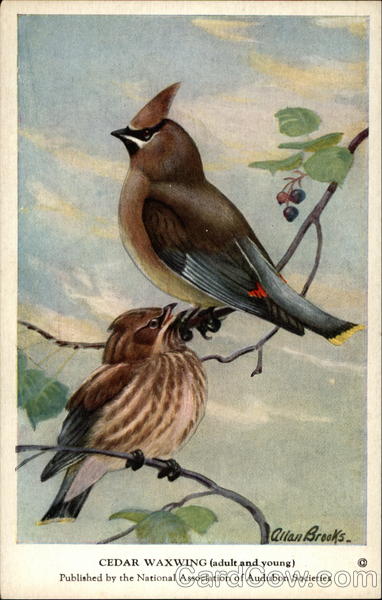Front:
allan Broaks.
CEDAR WAXWING (adult and young)
Published by the National Association of Audubon Societies
Back:
No. 40 Cedar Waxwing
Length 7 inches
The Cedar Waxwing is, in a special sense, a
bird of beauty and distinction. Its graceful form
and delicate plumage, combined with fine man-
ners and interesting habits, go far to make it an
aristocrat among the birds. It does not come about
our homes, however, with the regularity of such
tried friends as Robins, Bluebirds and Threshers.
The Waxwing is gregarious save during the
nesting season. The remainder of the year it
wanders widely about, appearing in companies
ranging from five or six up to fifts or seventy-
five. It is very fond of wild fruits and often
comes to feed on wild cherries, Dlackberries and
mulberries. When these are gone, ibis off to some
fresh feeding ground, flying in close formation
and wheeling in graceful motion as it again
alights. In addition to fruits and berries, the
Waxwing consumes large numbers of injurious
insects, and is thus very Yachtrable to the farmer
and orchardist.
The nest is a compact Btrfteture of twigs, mosses,
strings, wool, etc., in trees. There are four or five
eggs, bluish-white and speckled with black.
Classification: Order Passeres. Family Bombycillida.
Scientific name: Bombycilla cedrorum.
Range: Throughout North America, breeding from
Virginia and Missouri northward to southern Alaska.
It winters throughout the United States and Mexico
to Panama.
No. 40 from set of 50 Winter Birds of the Northeastern United
States. Published by the National Association of Audubon So-
cieties, 1974 Broadway, New York City. Price per set, in a box,
$1.00 post paid.



